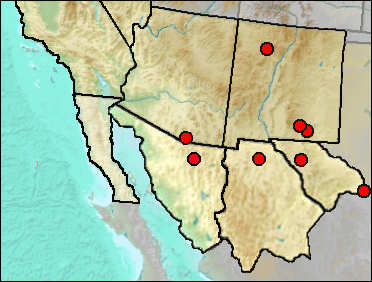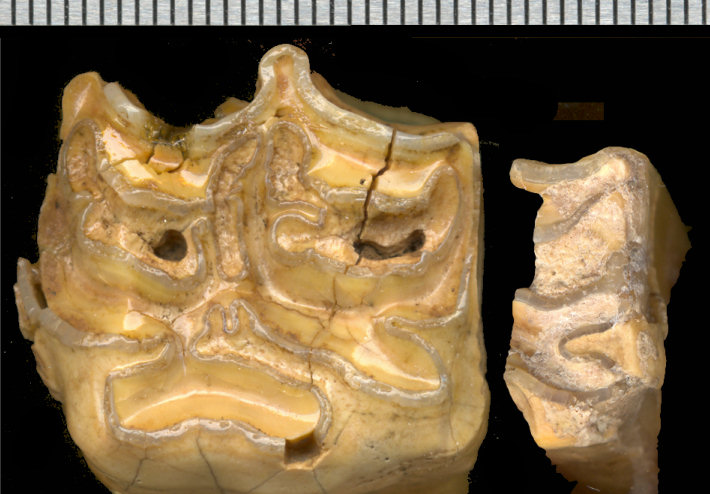Class Mammalia
Order Perissodactyla
Family Equidae
Equidae—Family Equidae // Equidae sp.—Horses // Equus sp. (small)—Small Horse // Equus sp (large)—Large Horse // Equus calobatus—Stilt-legged Onager // Equus conversidens—Mexican Horse // Equus cumminsii—Cummings' Ass // Equus enormis—Enormous Horse // Equus fraternus—Fraternal Horse // Equus giganteus—Giant Horse // Equus occidentalis—Western Horse // Equus pacificus—Pacific Horse // Equus (Plesippus) sp.—American Zebra // Equus (Plesippus) francescana—Francescana Zebra // Equus (Plesippus) simplicidens—American Zebra // Equus Species A—Unidentified Equus // Haringtonhippus francisci—Harington's Stilt-legged Horse

Synonyms. Equus altidens, Equus calobatus, Equus conversidens, Equus quinni, Equus littoralis, Equus semiplicatus, Equus tau, Equus zoyatalis.
Heintzman et al. (2017) considered Haringtonhippus to be monospecific. They considered nine species names that have been considered by some authors to be stilt-legged. They discarded eight for various reasons and picked E. francisci as the best choice for the type species. Heintzman et al. (2017) discuss their reasoning in picking francisi as the type species in some detail. For our purpuses here, the taxa listed above as synonyms are listed only on the basis as having been considered by some as stilt-legged species or as noted below.
Dalquest (1979) considered Equus francisci to be a synonym of Equus tau, and E. tau to be the only small, stilt-legged horse of the Pleistocene. He characterized it as the smallest of the North American Pleistocene horses.
Winan (1985, 1989) considered E. francisci valid species (or species group) of stilt-legged horse. In these, the length to proximal width of the metacarpal is generally greater than 5.0 and that of the metatarsal, greater than 6.0 (Winans 1989).
Possible occurrence in the Balcony Room site of Dry Cave is based solely on a single, partial upper tooth (Fig. 1) that is appreciably smaller than that of E. conversidens; teeth from Villa Ahumada likewise are identified to this taxon on the basis of small size. With the description of Equus cedralensis, this may no longer be defensable.
The La Brisca horse remains included a large horse and E. cf. tau, with the latter tentatively identified on the basis of small size (Van Devender et al. 1985).

Fig. 1. Occlusal views of an upper cheek tooth of E. conversidens (left) and that of E. francisci (right). Scale is in mm.
Based on molecular evidence, Weinstock et al. (2005) suggested that there may be only one stilt-legged horse in the North American late Pleistocene. Likewise, Barrón-Ortiz et al. (2017), based on tooth morphology and molecular evidence, recognized one stilt-legged species which they assigned to E. conversidens. Barrón et al. (2017) identified the small tooth from the Villa Ahumada site in Chihuahua as Equus cedralensis, but noted that the relationship between E. cedralensis and Equus tau and E. francisci is unclear, with similarities of dental morphology. Morphological differences among purported specimens of H. francisci suggest it is not monotypic.
Sites.
Rancholabrean: El Barreal (UTEP: ?); Papago Springs Cave (Skinner 1942); Villa Ahumada (UTEP: ?).
Sangamon: La Brisca (Van Devender et al. 1985).
Mid/Late Wisconsin/Holocene: Sierra Diablo Cave (UTEP).
Late Wisconsin: Balcony Room (Harris 1993c); Bonfire Shelter (Bement 1986); Burnet Cave (Schultz and Howard 1935: cf.); Cueva Quebrada (Lundelius 1984); White Mesa (Morgan and Rinehart 2007: cf.).
Literature.
Barrón et al. 2017; Bement 1986; Dalquest 1979; Harris 1993c; Heintzman et al. 2017; Lundelius 1984; Morgan and Rinehart 2007; Schultz and Howard 1935; Skinner 1942; Van Devender et al. 1985; Winan 1985, 1989.
Last Update: 7 Jul 2018